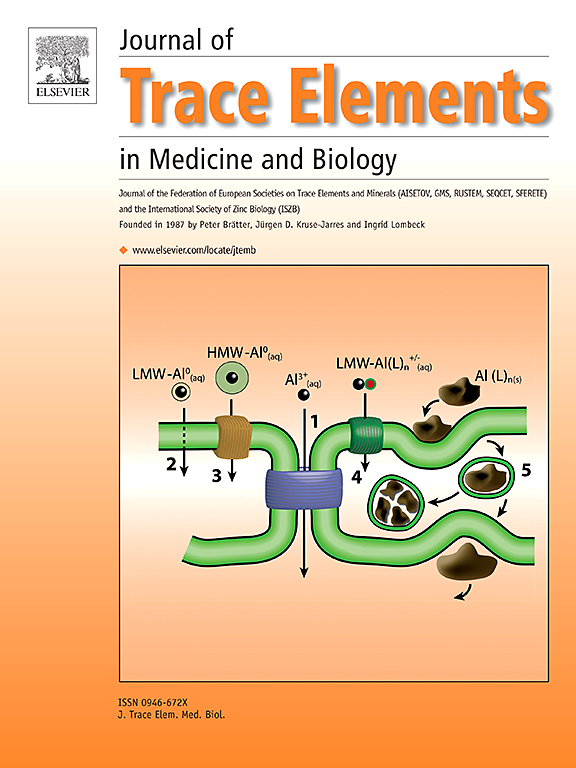The close relationship between trace elements (Cu, Fe, Zn, Se, Rb, Si, Cr, and V) and Alzheimer's disease: Research progress and insights
IF 3.6
3区 医学
Q2 BIOCHEMISTRY & MOLECULAR BIOLOGY
Journal of Trace Elements in Medicine and Biology
Pub Date : 2025-07-03
DOI:10.1016/j.jtemb.2025.127692
引用次数: 0
Abstract
Alzheimer's disease (AD) is a typical neurodegenerative disorder primarily characterized by the deposition of β-amyloid (Aβ) plaques and the hyperphosphorylation of tau protein, leading to the formation of neurofibrillary tangles (NFTs). These pathological changes are closely associated with the imbalance of trace element homeostasis. Trace elements are extensively involved in fundamental physiological processes, including DNA synthesis, protein synthesis, energy metabolism, and enzymatic reactions, all of which are essential for cognitive function and brain development. This review summarizes the alterations in homeostasis and the biological roles of trace elements such as copper, iron, zinc, selenium, rubidium, silicon, chromium, and vanadium, as well as their relationship with the onset and progression of AD. Additionally, we discuss recent advancements in therapeutic strategies targeting the balance of trace element ions, including metal chelators, supplements, nanomedicines, and small-molecule drugs, to provide new perspectives for AD research and treatment.
微量元素(Cu、Fe、Zn、Se、Rb、Si、Cr、V)与阿尔茨海默病的密切关系:研究进展与见解
阿尔茨海默病(AD)是一种典型的神经退行性疾病,其主要特征是β-淀粉样蛋白(a β)斑块沉积和tau蛋白过度磷酸化,导致神经原纤维缠结(nft)的形成。这些病理变化与微量元素体内平衡失衡密切相关。微量元素广泛参与基本生理过程,包括DNA合成、蛋白质合成、能量代谢和酶促反应,这些都是认知功能和大脑发育所必需的。本文综述了铜、铁、锌、硒、铷、硅、铬、钒等微量元素在AD发生发展过程中体内平衡的变化及其生物学作用,以及它们与AD发生发展的关系。此外,我们还讨论了针对微量元素离子平衡的治疗策略的最新进展,包括金属螯合剂、补充剂、纳米药物和小分子药物,为阿尔茨海默病的研究和治疗提供了新的视角。
本文章由计算机程序翻译,如有差异,请以英文原文为准。
求助全文
约1分钟内获得全文
求助全文
来源期刊
CiteScore
6.60
自引率
2.90%
发文量
202
审稿时长
85 days
期刊介绍:
The journal provides the reader with a thorough description of theoretical and applied aspects of trace elements in medicine and biology and is devoted to the advancement of scientific knowledge about trace elements and trace element species. Trace elements play essential roles in the maintenance of physiological processes. During the last decades there has been a great deal of scientific investigation about the function and binding of trace elements. The Journal of Trace Elements in Medicine and Biology focuses on the description and dissemination of scientific results concerning the role of trace elements with respect to their mode of action in health and disease and nutritional importance. Progress in the knowledge of the biological role of trace elements depends, however, on advances in trace elements chemistry. Thus the Journal of Trace Elements in Medicine and Biology will include only those papers that base their results on proven analytical methods.
Also, we only publish those articles in which the quality assurance regarding the execution of experiments and achievement of results is guaranteed.

 求助内容:
求助内容: 应助结果提醒方式:
应助结果提醒方式:


